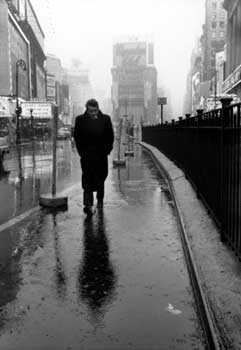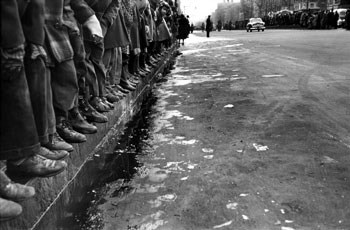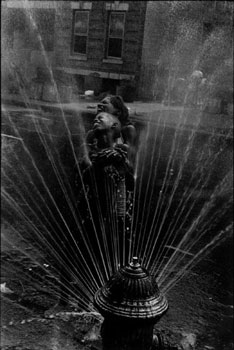 |
→ August 2004 Contents → Column
|
Once Upon a Time in New York: "Magnum's New Yorkers"
August 2004
|
 |
||||||
|
Recently in The New York Times, I read a review of an exhibition of photographs that attributed more to each photo, and collectively to the exhibit, than I thought possible. Called "Magnum's New Yorkers," the exhibit, currently at the Museum of the City of New York, explores New York through more than 30 Magnum photographers over the last half of the 20th century. This exhibition is unique and we should realize that we might not see the likes of this style of photojournalism again. This is Magnum's New York. It is not mine, and I am sure, not necessarily yours, but New York is where I spent my formative years and where I now live. The exhibit is strongly nostalgic for me, so perhaps I cannot be as critical as I would like.
I went to the museum at 103rd Street and Fifth Avenue to look at the pictures myself to see what the critic meant. I will not attempt to refute him word for word because there is not enough time or space to do so, but I will give you one more quote. He says, "Photojournalists don't bring us the news, they give us professionally processed images and stories — polished, plausible fictions — that we effortlessly understand because they are so much like stories and images we've seen before." It is a disturbing analysis of photojournalism, one I do not accept. I do not believe photojournalists working then and anyone at work today can or will accept the idea of "polished plausible fictions." That phrase is blatant nonsense. It ascribes a devious motive to the photojournalist that does not exist, at least among those I know. It says the photojournalist is deceitful, in fact lying, because he sees and records a different truth from the one in front of him. I have no idea how that is possible. This exhibit of photos from the late 1940's through 2002 does not represent all of New York, nor can it. Importantly, the pictures are what they are, what the photographer saw, rather than clever misrepresentations. I start with a prejudice, since I find most criticism of photojournalism suspect — because it makes of the image more than what it is. Critics are seeking to create a canon to describe their view. Most of the time what they would like us to consider as a critique does not apply. For whatever reason, critics raise the ante on what they expect of professional news photography. They never seem to consider that the photo either works or not, depending on the person who takes the picture, the vision, the angle, the warmth, the depth, its context, and obviously, the moment. The viewer then either accepts or denies the photograph from his own emotions. One photo is different from another. One photo is often better than another. How do we judge, and when we do, what standard do we apply? Mainly, we should judge news photos on how they reach us through what they say. In other words, the first impact should be visceral. After that, then we perhaps can deconstruct the meaning, but if we assume too much meaning, we lose the impact of the photo itself and that is something I do not want. All I would add to any new critical tenet is that yes, photography serves more than one spiritual master, the real and its reinvention. It is not a recreation, though; rather, a new reality caused by the sudden stoppage in time by the photographer when he takes his picture.
How do you compare photos unless, say, two photographers see the same subject — in reality no two people see anything exactly the same — then aim and click simultaneously? Is that possible? I think not. No two fingers move the same. No two brains work the same. No two eyes see the same. A minute fraction of a second changes everything. The two photos will be different enough to make them appear dissimilar in the eye of the viewer. Finger speed, eye, the adjustment of the lens, how the camera picks up light, even the stock used, including its age and storage, can change the outcome. Two photos taken 26 years apart show that even as time changes, so much else does not, such as loneliness, isolation, even place. One titled, "Brooklyn, 1947. At a Diner on Second Avenue," by Henri Cartier-Bresson, and the other, "Lower East Side, 1973. Garden Cafeteria," by Bruce Davidson, show a similar technique, a similar compassion, a similar understanding — perhaps qualities that being of Magnum bestows on its photographers. Yet, the twn="right">Henri Cartier-Bresson/Magnum | |||||||
In a similar vein, there is a moving photo that also speaks of the diversity of New York, this one by Burt Glinn: "New York, 1951, A Father With Children on the First Day of Alien Registration." Their faces appear impassive but perhaps they fear the unknown after their long journey. By looking closely I believe I can feel how deeply moved are the father and his children, about to embark on a new life.
Of course, no exhibit would be complete without celebrities. Here, they are unposed, natural stars in their element, and particularly nostalgic for me. "Times Square, 1955. James Dean," by Dennis Stock, is a full-frame shot of James Dean, that troubled icon, walking by himself, seemingly in a hurry as was his image, bundled in an overcoat and where I walked myself many times. It evokes the loneliness of James Dean that only reinforces his iconic image. How did Stock get the shot? Was it serendipity, good fortune? Does it matter?
Another by Dennis Stock, also a wonderful shot, is "Miles Davis, 1958. Performing at Birdland." Birdland was a hangout for me in those years and as I looked at Miles playing his trumpet on stage in the background but clearly the main subject, with smoke rising from the crowd, I could only wonder, was I present the night Stock took his evocative photo?
 | |
Times Square, 1955. James Dean Dennis Stock/Magnum | |
The last photo on my list reflects on a celebrity who is not in the picture. The black-and-white photograph, by Cornell Capa, is "Harlem, 1949. Crowds Line Broadway Awaiting the Funeral Procession of William 'Bojangles' Robinson." The shot is taken from a low angle on a wide street which seems to go on forever. At the bottom on the left begins a seemingly endless row of shod feet, the shoes worn and scuffed, all side-by-side. The feet are not moving at all as these men patiently wait for 'Bojangles,' one of the great tap dancers of all time, to pass before them on his final trip to the cemetery. Perhaps in their minds, he is dancing his way to his grave. Cornell Capa's photo, with those immobile shoes, makes me think about the dancing feet of a master when he was alive. I cannot ask more than that of any photograph.
I did not include any photos from the last years of the 20th century. Perhaps they are too close to the time we live in now. Some of the older photos remind me of my youth and are subtle lessons in the soul and spirit of the creative photojournalist.
Each is different, yet each is similar because they are the heart of Magnum: individual vision combined with the best of photojournalism. They move us and, as they should, they make us smile. They touch our memory, they help us to understand who we are and allow us to share the unique moment of each photograph.

